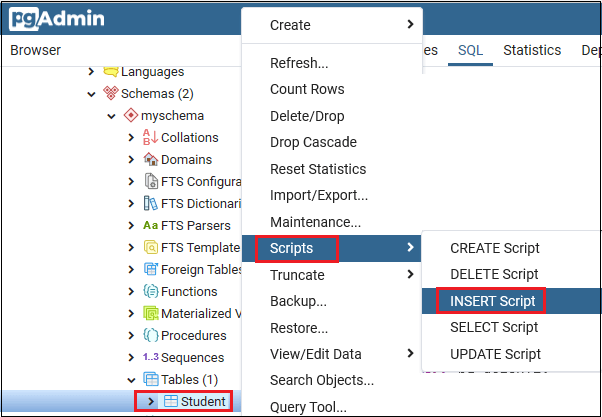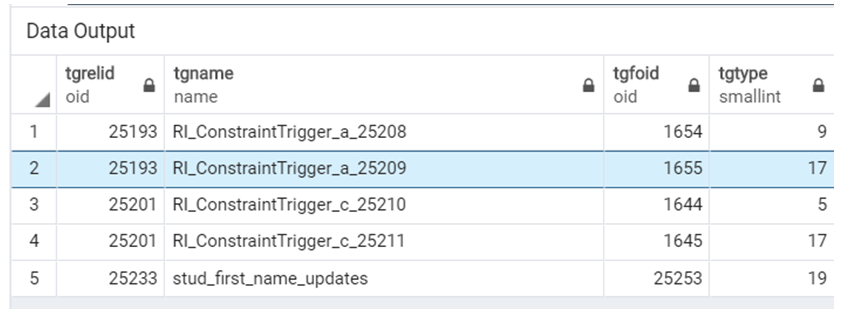

- #POSTGRESQL INSERT TRIGGER HOW TO#
- #POSTGRESQL INSERT TRIGGER UPDATE#
- #POSTGRESQL INSERT TRIGGER CODE#
Of logic would have to be taken care of by the application, not the DB. Idea is that I want to have some tables that treat repeated inserts as updates otherwise that piece I know it is straightforward to write insert.
#POSTGRESQL INSERT TRIGGER UPDATE#
Update whenever an insert would fail because of a uniqueness constraint? Test the trigger by attempting to drop the EMPLOYEES table.In PostgreSQL 9.6 and later, what is the correct way to define a trigger function that will perform an SEQUENCE', 'DROP MATERIALIZED VIEW', 'DROP TYPE') WHEN TAG IN ('DROP TABLE', 'DROP VIEW', 'DROP FUNCTION', 'DROP CREATE EVENT TRIGGER trg_abort_drop_command RAISE EXCEPTION 'The % Command is Disabled', tg_tag Ĭreate the event trigger, which runs before the start of a DDL DROP command. CREATE OR REPLACE FUNCTION ABORT_DROP_COMMAND() Note that trigger functions are created with no arguments and must have a return type of TRIGGER or EVENT_TRIGGER. This is the same as a SQL Server DDL System/Schema level trigger, such as a trigger that prevents running a DDL DROP on objects in the HR schema. SELECT PROJECTNO FROM EMP WHERE PROJECTNO=123 Ĭreate an event trigger function. DELETE FROM PROJECTS WHERE PROJECTNO=123 Test the trigger by deleting a row from the PROJECTS table. IF TG_OP = 'UPDATE' AND OLD.PROJECTNO != NEW.PROJECTNO ORĬreate the trigger. CREATE OR REPLACE FUNCTION PROJECTS_SET_NULL() ExamplesĬreate a trigger function that stores the run logic (this is the same as a SQL Server DML trigger). You can use it with AFTER trigger to interact with the overall view of the OLD or the NEW TABLE changed rows. REFERENCING is a new option since PostgreSQL 10. Triggers provide much of the same functionality as SQL Server: The batch has been aborted.įor more information, see DML Triggers and DDL Triggers in the SQL Server documentation. Tables Can't be dropped in this database. The system displays the following message explaining that the Invoices table can’t be dropped: Msg 50000, Level 16, State 1, Procedure PreventTableDrop, Line 5 Test the trigger by attempting to drop a table. RAISERROR ('Tables can't be dropped in this database', 16, 1) NULL NULL NULL 3 James 677.22 20180224 13:02 Domain/JohnCortneyĬreate a trigger to protect all tables in the database from accidental deletion. InvoiceID Customer TotalAmount InvoiceID Customer TotalAmount DeleteDate DeletedBy SELECT *įor the preceding example, the result looks as shown following. INSERT INTO InvoiceAuditLog (InvoiceID, Customer, TotalAmount) CREATE TABLE InvoiceAuditLogĭeleteDate DATETIME NOT NULL DEFAULT (GETDATE()),ĭeletedBy VARCHAR(128) NOT NULL DEFAULT (CURRENT_USER)Ĭreate an AFTER DELETE trigger to log deletions from the Invoices table to the audit log. INSERT INTO Invoices (InvoiceID,Customer,TotalAmount)Ĭreate the InvoiceAuditLog table.
#POSTGRESQL INSERT TRIGGER HOW TO#
The following examples demonstrate how to use a trigger to log rows deleted from a table.Ĭreate and populate the Invoices table. Use a DML trigger to audit invoice deletions For INSTEAD OF triggers, the DML statement doesn’t run and doesn’t require a rollback.
#POSTGRESQL INSERT TRIGGER CODE#
If the trigger code issues an explicit ROLLBACK, or causes an exception that mandates a rollback, the DML statement is also rolled back. SQL Server triggers always run within the transaction of the statement that triggered the run. These tables contain the entire set of changes performed by the DML statement that caused trigger run. The data modified by the DML statement is available to the trigger scope and is saved in two virtual tables: INSERTED and DELETED. The trigger code runs once for each statement. SQL Server supports statement level triggers only. You can use it to set the first and last triggers to be run, but not the order of others. When multiple AFTER triggers exist for the same event and object, you can partially set the trigger order by using the sp_settriggerorder system stored procedure.

You can create only one INSTEAD OF trigger for any given object and event. You can create INSTEAD OF triggers on tables and views. You can create AFTER triggers on tables only. INSTEAD OF triggers run code in place of the original DML statement. Trigger RunĪFTER triggers runs after DML statements complete run. SQL Server doesn’t support FOR EACH ROW triggers in which the trigger code is run once for each row of modified data.


 0 kommentar(er)
0 kommentar(er)
